5 Things to Make with Hollyhocks
Learn 5 ways to use hollyhocks – a lovely old-fashioned garden flower that’s completely edible and non-toxic!
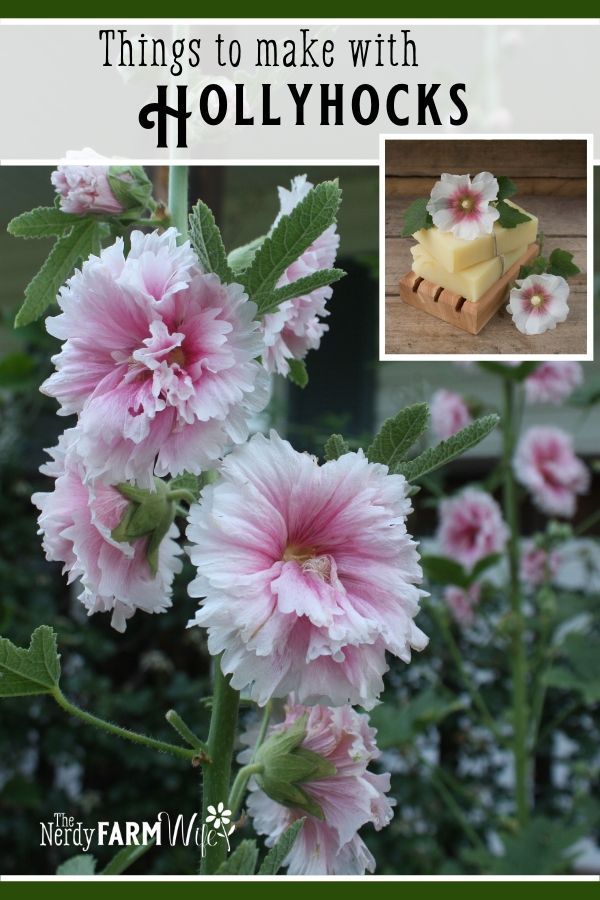
Many people don’t realize that the common garden flower, Hollyhock, is completely edible – root, leaves and blossoms – and useful for more than just its charming looks.
Hollyhock is related to Marshmallow and can sometimes be used as a milder substitute for that herb; a primary exception being that Hollyhocks have woodier and tougher roots, and are less palatable for eating purposes than Marshmallow’s softer roots.
One thing to remember about this plant is that high heat and alcohol can denature some of the healing properties, so, for the most part, avoid those two methods of preparing or preserving Hollyhock when using for medicinal purposes.
Some uses for Hollyhocks include:
1. Hollyhock Cold Infusion
Taken internally, Hollyhock is soothing to the gastrointestinal, respiratory and urinary tracts in the human body. When you have a sore throat and it’s hard to swallow, try a cold infusion of Hollyhock. (For a persistent sore throat that isn’t helped by common home remedies, be sure to check with your health care provider.)
To make, simply gather a handful of fresh flowers (you can use dried also) and fill the center of a square of cheesecloth. Wrap the sides up to form a crude tea bag of sorts and tie with baking string, or in a pinch, I’ve used unwaxed dental floss. Drape the string over the edge and use the lid to hold it in place. You want to keep it submerged near the top of the water. Leave in place in the refrigerator overnight, then remove the makeshift bag. Refrigerate the resulting infusion and use within one to two days.
You can also use this cold infusion to replace the water amount in soothing soap recipes. (See below.)
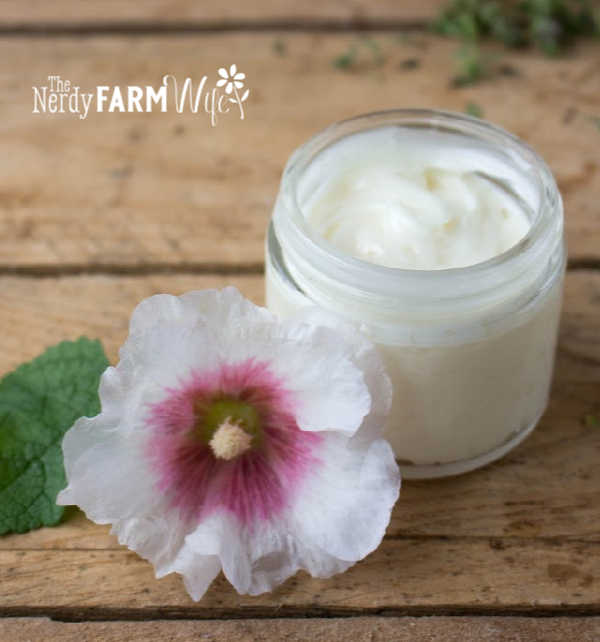
2. Hollyhock Split-End Cream
While a trim is the only sure fire way to get rid of split ends, this hair cream can help out between hair cut appointments.
This recipe is straight from the pages of my print book, The Big Book of Homemade Products. Look for it at your favorite book seller or Amazon.
To make this, you’ll need:
- 2 tbsp (28 g) argan oil
- 1 tbsp (1 g) crushed dried hollyhock flowers or leaves
- 1 tbsp (14 g) shea butter
- 1 tbsp (15 ml) aloe vera gel
- 2 to 3 drops of your favorite essential oil
- preservative of choice (see note below)
Directions to make:
Infuse the argan oil with hollyhocks. (If you’ve never infused oil before, use the same method as for making plantain infused oil as written in my article about 10 Things to Make with Plantain.)
In a small jar, melt the shea butter by placing the jar into a small saucepan of hot water. Once melted, combine it with the hollyhock infused oil.
Place the oil and butter mixture in the refrigerator for around 30 minutes, or until it starts to firm up. Using a fork, stir well.
Add the aloe vera gel, preservative, and essential oil, if using. Stir the mixture vigorously for a couple of minutes, until it turns opaque and creamy.
Set the mixture aside to cool for about 5 minutes, then stir thoroughly once more with a fork. You should now have a thickened cream.
To use:
Dab a very small amount on your fingertips. Working with one section at a time, lightly rub the cream just into the ends of your hair. Go light on amount used – a little bit will go a long way!
Preservative note:
My favorite natural preservative changes over time, so I tend to vary which one I use. Currently, I would recommend using 2 grams of Phytocide Elderberry OS (oil soluble natural preservative), but mixing it in with the melted butter and oils, right before refrigerating. (I determined that amount by deciding on a 3.5% usage rate for this batch, which is 60 grams.)
If you wanted to use a water soluble preservative, such as Leucidal SF Max (natural) or Optiphen Plus (not natural, but paraben-free and formaldehyde-free), add it with the aloe. (You would use 2 grams Leucidal SF Max, or 0.6 g Optiphen Plus.)
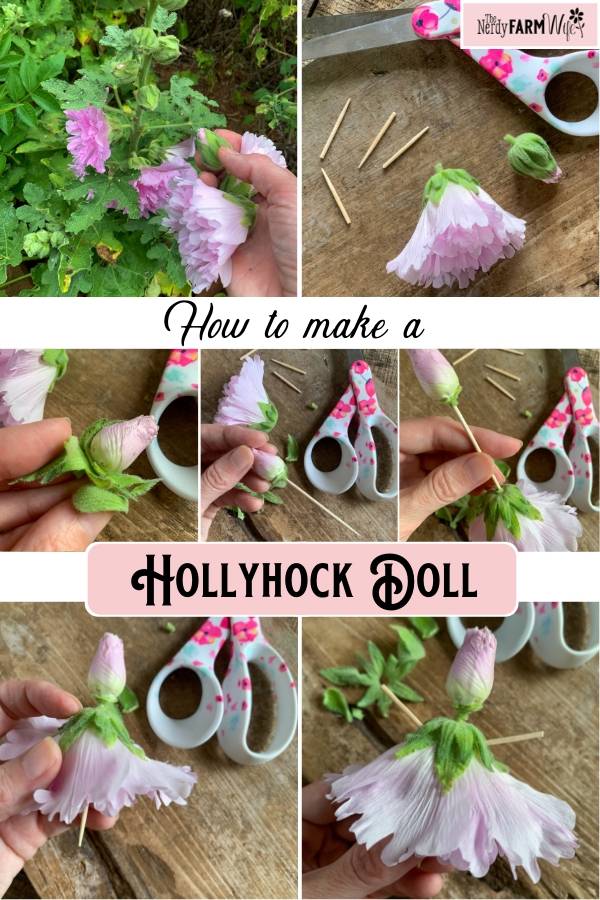
3. An Old-Fashioned Hollyhock Doll
This is not an herbal use, but a fun thing to show the kids!
To make, find a small bud and carefully peel away the green underside. You will reveal a tiny “face” with eyes; this will be the head of your doll.
Take a fully opened flower, turn upside down and secure the head to it with a toothpick. Now your doll has a beautiful dress with a full ruffled skirt!
Add additional toothpick halves for the arms.
This simple dolly is completely non-toxic so can even be used to decorate food and drink, as long as you are sure the child is old enough to be careful with the toothpicks.
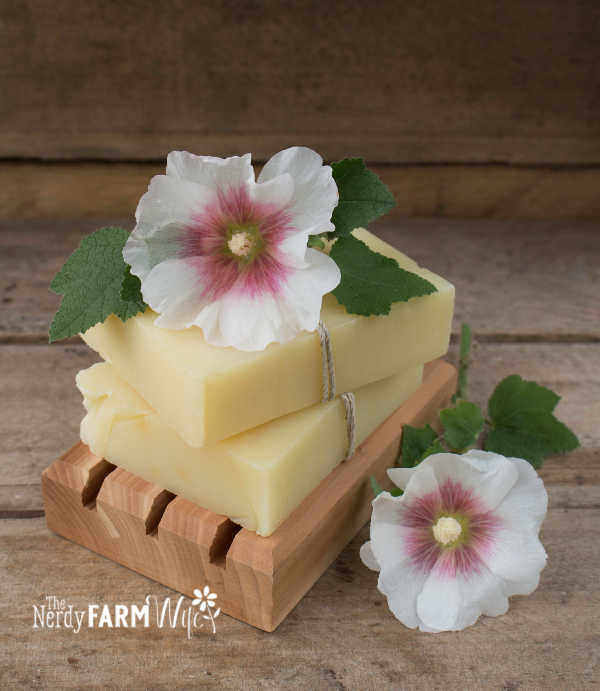
4. Hollyhock Soap
You probably knew this one was coming! :)
I tend to turn every beneficial thing growing around here into a soap, Hollyhock being no exception!
For a recipe on my site, I used a cold infusion of Hollyhock for the water part of my recipe and added a tiny pinch of rose clay for color – an easy way to personalize your favorite basic soap recipe. Click here for that recipe!
5. Butterfly Host Plant
Hollyhocks are so easy to grow and so pretty to look at, why not try your hand at growing (and using!) some this year?
Mine were handed down to me by my mother, but a great place for pure, untreated, heirloom seeds is Baker Creek Heirloom Seeds.
They’re very drought resistant and do well in poor, hard soils – which is a bonus for me, because as a general rule, the dirt around here is pretty much red clay. Not only do my Hollyhocks come back year after year, they have thrived in a section of my yard that contains such hard dirt, I have to enlist the help of my husband’s muscles just to dig in the area.
These are fun for kids to grow too; a special bonus being that Hollyhocks are a preferred host for Painted Lady Butterflies. We definitely want to help butterflies and pollinators out as much as we can these days!
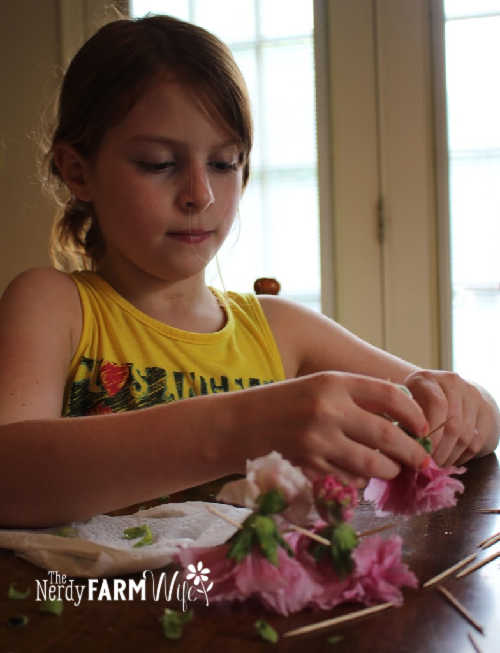
I hope this post has not just opened your eyes to some lesser known uses of Hollyhock, but also will encourage you to look around and find the hidden treasures in everything growing around you.
A little research and a bit of experimentation and you never know what amazing thing you will find out next!


Jan, I totally agree with you that hollyhocks are a lovely and useful addition to any cottage garden. My favorites are the double black ones. I have to remember to reseed them so I can enjoy them annually.
Oh those sound really pretty! I’d love to have more varieties at my house. :)
No, I am not surprised you made a hollyhock soap – so cool! I don’t think I have ever seen a hollyhock, but you have the COOLEST ideas!
Thanks Jane! Once you get started your soap making adventure, I can’t wait to see what ideas you come up with too! :)
Always glad to have another excuse to grow flowers :) Great information!
Me too! :) and thanks!
Visiting from Frugally Sustainable’s link up.
Girlfriend, you have officially rocked my world with this one!
haha :) Thanks for stopping by!
I love the little doll! OK, I love the other uses for it too, but the doll is so cute!
Thanks for sharing with my Super Link Party! :-)
The doll is my favorite too! :) I still have one in my fridge that I made days ago… they last quite a while, floating in a little bowl of water!
I’ve always loved hollyhocks but never knew they were so useful! Thanks for sharing on Wildcrafting Wednesday! :)
Thank you for the opportunity to link up! :)
I never knew they were edible!
I didn’t either for most of my life! The leaves taste a little bit like fuzzy lettuce. Edible, but… furry. :)
Do animals like deer, rabbits, and javelina eat them also? Arrived at my mountain cabin and see many of them have missing leaves–lots of stems sticking up and only newer emerging leaves on plant base.
Hi! I’ve heard they’re deer resistant, but mine are planted so close to the house, I’m not sure. The worst offenders are my chickens – they keep scratching up the area where they grow. New fencing is on the list!
Oh I have so many Holly hocks thank you this is very interesting. B
I’m glad you found the information useful! :)
Wow! Never knew this ~ Have always loved Hollyhocks ~ love them even more now ~ thanks for the very creative and informative post ~ ^_^ (A Creative Harbor)
Hi! I’m glad you enjoyed reading. :)
What a fun post! I have hollyhocks growing for the first time this year and did not know that they were edible or medicinal and I love, love the little dolly! :)
Yes, they are wonderful plants & so very pretty! I love the dolly too. :)
Ours are doing fantastically this year! I love the one you have featured — such a beautiful shade of pink.
Thank you for sharing at Rural Thursdays this week. xoxo
Thank you for letting me share my post! :)
Who knew the hollyhock was so useful? Thanks for the great ideas! My grand-daughter and I are going to go looking for some hollyhocks for dolly makin’!! Thanks for sharing this post with Farm Fresh Friday! Have a great weekend!!
Have fun! I hope you have a great weekend too! :)
Jan
Neat ideas for Hollyhocks. Just the other day I had a friend telling me about Hollyhock dolls.
Thank You for stopping in at my blog and leaving a nice comment. I appreciate it!
Thanks for returning the visit! :)
Wow! I had no idea these flowers were so useful! I love learning about edible flowers and weeds :) Thanks so much for sharing this at Tiny Tip Tuesday! I’m pinning this :)
Thanks for visiting and pinning Sarah! :)
Did you know chickens love the leaves, as well?
Thanks for posting about the doll. We did this as children but so long since I was a child, couldn’t remember how to make the head!
Does the infusion color your soap at all or is that color entirely from the clay you added?
I always have hollyhocks, and I love the old singles. Purples, pinks, white and red. They will grow almost anywhere. I even have one right now, growing between the crack where the bottom concrete step meets the concrete sidewalk. It’s blooming.
When my hollyhocks are done, I harvest the seed and then cut the stalk up with my loppers, into pieces about one to two inches long. Then they go into the compost.
I didn’t realize chickens like the leaves also! My little puppy follows me around when I gather herbs and flowers sometimes and she tries to chew on the lower leaves of hollyhocks (and mint) all the time!
The pink color is from the clay; the soap would be an off white otherwise. It only took a tiny pinch; in fact, I’d put even less next time. I was going for just a tiny hint of pink…
I love the looks of the old fashioned singles too – I want to grow more varieties around here! :)
I didn’t realize chickens like the leaves also! My little puppy follows me around when I gather herbs and flowers sometimes and she tries to chew on the lower leaves of hollyhocks (and mint) all the time!
The pink color is from the clay; the soap would be an off white otherwise. It only took a tiny pinch; in fact, I’d put even less next time. I was going for just a tiny hint of pink…
I love the looks of the old fashioned singles too – I want to grow more varieties around here! :)
Oh, my chickens DEVOUR my Hollyhocks! lol And so do the deer- which is why I was so certain they could be eaten, I just didnt want to try it out on myself and couldnt find any info on them actually being ingested.
Got your website from the Little House in the Suburbs folks. I love your creativity with hollyhocks. They’re a beautiful, old-fashioned flower I’d forgotten. Please tell me the name of the beautiful pinks you show in your photos. I must have some!
Thank you! :) I wish I knew the name – I dug up some plants from my mom’s house (mostly red hollyhocks) replanted them in my front flower beds, and then the next year these came up along with some single pink ones! I suppose some of the random color seed was mixed in her soil. I’ve yet to get a red blossom again! These pink ones are so lovely though. If I ever find out the name, I will reply with an update! :)
Oh my… Do you know that you’ve catapulted me into my long ago childhood in the ’60s. My great grandmother used to make Hollyhock dolls for me and I havent thought about it since. Thank you so much for bringing back those memories & my love of them.. I cant tell you how much it means to me.
You’ve got a new fan.. I came from Little House’s blog & link too! Have a wonderful day!
Thank you Kim! I’m so glad to have stirred a happy memory for you! :) My mother used to take me on nature walks and show us things her father taught her to do with leaves and flowers… I’ll never forget her showing us how to make a perfect drinking cup from a leaf. Such wonderful memories. :)
Thank you for posting this! I just KNEW Hollyhocks had to be good for something! I have raised them for many years, using seeds from my mother, who got them from her grandmother- I love the beauty and heritage in my Hollyhocks, but didnt know if I could eat them. Now I’m going to try using the leaves like grape leaves to make little rolls! :D (it really helps that they will grow well anywhere and with very little or no care)
Hi Michelle, I’m happy you stopped by! What a wonderful heritage of hollyhocks. I keep saving my seeds each year, though they reseed so nicely too. I love the flowers! :)
I was at the market local to my job earlier today and it caters primarily to our Iranian community. I am always on the lookout for new vegetables to try, especially leafy greens. the one stall was selling hollyhock leaves. this was completely new to me. the stallholder said that they were best cooked by sauteeing in oil with some garlic and served with lemon juice added at the end of cooking. something to try. I love your Hollyhock dolls!
We’ve had such a mild winter, that my hollyhocks have put out a ton of small green leaves. I was just looking at them the other day, thinking that I should make good use of them! I will have to try that way out!
Thanks for your article! We are on the cusp of soap-making here and your recipe is received with thanks. I ‘ll be sure to pass it on to my soap making friends!
I’m glad that you like it! I’m right in the middle of revamping the recipe to make it palm free, so that change should be reflected on here soon. So, you might want to check back in a week or so and get the other version as well. :) Happy soap making!! :)
Wow!
Thanks for inspiring information – and pictures…
Not all hollylock I see looks as nice as yours – which variety is this?
Hi Carsten, Thanks! I’m not sure of the variety since I got them from my Mom’s flower beds and she’s had them for years. I’ve been on the lookout though & hope to find out the name one day! :)
Thanks for this useful information about a flower I already adored. Now there is so much more to love ABOUT them! What has really been fun for me is that my vegetable garden area has been volunteering several hollyhocks each year. I believe I have some bird friends to thank for that!
How wonderful to have volunteer hollyhocks! They are one of my favorites too. I’m glad that you found the information useful!
I grew up in Northern Virginia, where my Grandmothers and Mother and Aunts all grew Hollyhocks. I’ve loved them since I was I child.
I had lots of them when I was still North, but I have moved to Coastal South Carolina, and I cannot get them to grow here! Help! Is it the heat, the sand, any ideas??
Hi Kippy! They do well for me here (I live in Virginia too), but this past summer was a lot rainier than normal and they suffered. They didn’t bloom anywhere near as long as usual and developed rust quickly. From my recollections of visiting South Carolina in my younger years, I remember it being very humid. If that’s the climate where you live, perhaps that’s a factor? The heat could be an issue as well, but I’m not positive about their requirements. I’m so sorry they won’t grow for you there – maybe if you researched through several online seed suppliers and asked them for recommendations, they could help?
I had an uncle who farmed and he didn’t like hollyhocks because he associated them with the outhouse. Evidently his mother planted them near the outhouse as camouflage.
And, for some reason, they grew beautifully. :-)
Hi Stephanie, I’ve heard them referred to as an outhouse plant too! :)
I Love Holly Hocks!! My Grandmother was from England and always had what I thought was a Beautiful Old English Flower garden. She and my Mother used to cook, make teas, use for medicinal purposes, and many other things, but most of all I remember the fun Dolls she made from the Holly Hocks for all us grand kids!! Thanks for sharing this and regenerating the memories! I am going to do it for my Grandchildren!! <3 ^_^
What a wonderful memory! I love old English flower gardens – I bet it was beautiful! I hope your grandchildren enjoy making the flower dolls as well! :)
I have really enjoyed looking through your website. Found it through Hobby Farms. I now have saved in my favourites. So many recipes nature…can’t wait to try a few of them. Thanks for posting all your recipes and info.
Thanks! I’m so happy that you like the recipes!
We’ve just bought our first house with garden included and have been trying to work out which flowers we have and which are edible or medicinal. We have these in white, bright pink and dusky dark purple…. Your website is brilliant. We’ve just made the dolly and will look at some of the drink too! Thank you for your useful information sharing :)
Hi Melanie, How wonderful and fun to have a garden full of mystery flowers to research and enjoy! I’m happy that you found the hollyhock ideas useful! :)
I never knew you could use hollyhocks. I grow the black ones. Thanks for the inforation about the tea and leaves!
Hi Anna, Black hollyhocks are so striking; I know you must enjoy them in your garden! I’m glad you found the information useful!
Hi. I wonder if anyone can tell me please. When the seeds are ready can I put them with other seeds on the bird table. It seems a shame not to give some to the birds if they eat them.
Thank you
Hi Christine! Yes, you sure can let the birds have some of the seeds.
That’s really wonderful that you’re taking such good care of the birds where you live! :)
Can I buy some of your hollyhock seeds? Email me please if it is possible. Thanks :)
Hi Laura! Between my chickens dust bathing in my front flower bed and some rose bushes that went crazy, I only had one hollyhock plant come up this year and it was a single flowered one. I’m hoping someone in my family has a seed or two stashed and that I didn’t lose my pretty double pink flowers for good!
Prayerfully it will come back next year! My old neighbors who moved years ago had planted hollyhocks and the new owners and successive renters that have lived there since have badly neglected the yard but all the hollyhocks (of different single flowered colors) keep coming back. I saved seeds from them this year to grow some but I like the look of yours much better. :)
Jan, I really enjoyed this post. I didn’t know that painted lady butterflies layed their eggs on hollyhocks. Another use of the darker rose, red, or black flowered hollyhock is as a dye plant. They give very interesting and vibrant colours with an alum mordant. Only use the flowers. The green parts of the plant give a golden yellow.
Hi Chris, Thanks for the information! My daughter and I want to learn more about using plant dyes this year, so it will be fun to experiment with hollyhocks too!
We’ve got hollyhocks spreading all over the place. Nice to know there’s something else to do with them besides admiring them.
How wonderful to have so many hollyhocks! I’m glad you found the ideas useful! :)
Wonderfully informative! And I enjoyed your photos too! We are getting ready to plant some Hollyhocks on our little homestead and searched for info about their potential usefulness. That’s how we came across your post. I’m most looking forward to the infusing, as I often do this with Thrive Life fruits. I want to try combining!
Hi Holly, I’m glad you enjoyed the information & I hope you enjoy your hollyhocks growing on your homestead! :)